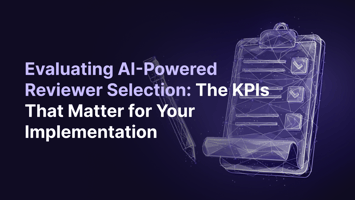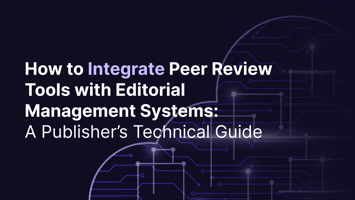The integration of artificial intelligence into peer review processes presents fundamental...
Practical AI in Peer Review Implementation Guide: From Organizational Readiness to Workflow Integration
The academic publishing world stands at a critical juncture where AI implementation has moved from theoretical possibility to operational necessity. Yet the gap between recognizing AI's potential and successfully integrating it into daily scholarly workflows remains substantial.
Through our work across diverse publishing environments, we've observed that successful AI implementation follows predictable patterns—and failures often stem from overlooked organizational dynamics rather than technological limitations. This guide distills practical insights from real-world implementations to help scholarly publishers navigate the journey from evaluation to operational success.
The Organizational Readiness Foundation
AI implementation success begins long before technical integration discussions commence. The most critical factor we've identified isn't technological sophistication—it's organizational alignment between stakeholders who will use AI tools and those who must approve them.
Consider this revealing pattern: research organizations can evaluate AI solutions and recognize clear value within minutes, yet still find themselves waiting months for internal approval to proceed. We've observed European research funding agencies where scientific officers understood the value proposition and prepared for deployment, only to halt everything when legal departments required additional evaluation of data handling protocols and security frameworks.
This disconnect reveals a fundamental truth about AI implementation: technical readiness must be matched by organizational coordination capabilities.
Identifying Implementation Readiness Markers
Organizations successfully integrating AI tools consistently demonstrate specific characteristics during evaluation periods:
Cultural Readiness Indicators:
- Active trial engagement with multiple test cases across different manuscript types
- Regular attendance at technical sessions with questions focused on implementation rather than general capabilities
- Specific customization requests demonstrating genuine workflow integration planning
- End-user advocacy during decision-maker discussions, creating internal alignment
Warning Signs of Implementation Challenges:
- Passive trial participation with minimal testing beyond initial demonstrations
- Focus on comparison shopping rather than implementation planning
- Limited questions during technical discussions, suggesting insufficient internal preparation
- Silence from actual workflow users during evaluation processes
Building Stakeholder Alignment
The most successful implementations address multiple stakeholder concerns simultaneously rather than treating them as sequential hurdles:
For Technical Teams: Extended trial periods, detailed integration documentation, and comprehensive debugging support ensure solutions meet operational requirements rather than theoretical specifications.
For Compliance Departments: Comprehensive security documentation, data protection policies, and clear explanations of how information remains on customer premises address legitimate concern about AI data handling.
For Decision Makers: Clear demonstrations of workflow improvements, efficiency gains, and measurable outcomes help justify investment and change management efforts.
Technical Integration Strategy: Building for Real Workflows
The technical landscape of scholarly publishing presents unique challenges that theoretical AI discussions rarely address. Editorial management systems vary dramatically in capability, from robust platforms with comprehensive APIs to legacy systems that would challenge any integration effort.
The Dual-Track Integration Approach
Based on extensive integration experience across diverse publishing environments, we've developed what we term a "dual-track integration strategy" that accommodates this technical reality:
Track 1: Native API Integration For established systems with existing APIs, direct integration with their infrastructure can achieve full functionality within days when documentation is clear and test environments are available.
Track 2: Universal API Architecture For the majority of cases—legacy systems, custom platforms, or environments with limited technical resources—we've developed a three-layer approach:
- Layer 1: Simple candidate lists appearing directly within existing editorial systems, solving immediate "tip-of-the-tongue" challenges without workflow disruption
- Layer 2: One-click access to comprehensive analysis while maintaining manuscript context, preventing editors from losing their place in established workflows
- Layer 3: Seamless result integration back into editorial systems via API hooks, eliminating manual data entry that typically kills adoption
This layered approach allows publishers to choose integration depth based on technical resources and workflow preferences.
Debugging and Reliability Considerations
Real-world AI integration requires robust debugging capabilities built from the outset. We learned this lesson through challenging integrations where traditional debugging approaches—submitting support tickets and waiting for development cycles—could have extended problem resolution for months.
Essential Debugging Infrastructure:
- Real-time visibility into API requests and responses for both systems
- Dynamic response modification capabilities for isolating specific integration issues
- Comprehensive logging with millisecond-accurate timestamps for performance analysis
- Binary search debugging methods for efficiently identifying problematic data fields
The key insight: debugging transparency builds trust between integration partners and enables collaborative problem-solving rather than finger-pointing when issues arise.
Workflow Integration Without Disruption
The most common AI implementation failure stems from workflow disruption rather than technical inadequacy. Editorial teams operate with finely tuned processes managing dozens of manuscripts weekly. Asking them to export manuscripts manually, switch between systems, and manually input results creates unsurmountable friction.
Understanding Editorial Workflow Reality
Before any technical planning, successful implementations begin with workflow analysis. This means observing how editorial teams actually work rather than how organizational charts suggest they work.
Critical Workflow Preservation Principles:
- Maintain manuscript context throughout the review process to prevent editors from losing their place
- Eliminate manual data entry between systems that creates bottlenecks and error opportunities
- Preserve existing communication patterns with authors and reviewers
- Support established quality control and approval processes
The Self-Service Solution Model
One of our most significant workflow improvements came from replacing manual administrative processes with self-service systems. Previously, journal activation required days or weeks of manual configuration. Now, unknown journals receive automatic responses with secure "claim journal" links that enable five-minute activation through cryptographically protected, single-use tokens.
This approach demonstrates how AI implementation can reduce administrative overhead while improving user experience and system reliability.
Building Inclusive AI Systems
AI implementation presents unique opportunities to address long-standing diversity challenges in peer review while raising ethical questions about algorithmic bias that require careful consideration.
The Diversity Enhancement Opportunity
Traditional peer review often relies on familiar networks that inadvertently limit reviewer diversity. As one editor candidly acknowledged: "The temptation can be to call upon people that we've worked with before." This pattern, while understandable under deadline pressure, works against efforts to expand reviewer diversity.
AI systems processing comprehensive databases can identify qualified reviewers across demographics, geography, and career stages that human memory might overlook:
Systematic Diversity Capabilities:
- Geographic distribution analysis ensuring global perspective representation
- Career stage filtering to include early-career researchers with specialized knowledge
- Gender and demographic diversity tracking for balanced reviewer pools
- Institution diversity to prevent concentration in specific academic networks
Addressing Algorithmic Bias Concerns
AI tools built on historical data risk perpetuating existing biases unless carefully managed. This requires both technical safeguards and human oversight throughout implementation.
Bias Mitigation Strategies:
- Transparent recommendation logic enabling human evaluation of AI suggestions
- Regular auditing of recommendation patterns for demographic representation
- Structured co-review models pairing experienced reviewers with diverse contributors
- Clear human override capabilities ensuring editorial judgment remains supreme
Practical IDEA Implementation Steps
Rather than overwhelming systemic changes, effective IDEA integration begins with targeted improvements:
- Audit current reviewer pools to establish baseline diversity metrics
- Identify one underrepresented group for focused initial outreach
- Implement pilot co-review programs with new reviewers from diverse backgrounds
- Create simple tracking mechanisms for diversity progress measurement
- Establish recognition programs acknowledging reviewer contributions across career stages
Overcoming Common Implementation Barriers
Our experience across numerous implementations reveals predictable barriers and proven solutions for each challenge type.
The Journal Name Chaos Problem
Editorial management systems often use inconsistent journal name formats—the same journal might appear as "Journal of Applied Physics," "J. Appl. Phys.," or various other abbreviations. This creates mapping challenges that can derail integration projects.
Solution: Automated journal claiming systems that eliminate manual mapping requirements while maintaining security through cryptographic verification processes.
The Approval Process Coordination Challenge
Organizations frequently encounter scenarios where end users enthusiastically support AI implementation while procurement departments create indefinite delays due to frameworks designed for physical goods rather than iterative software relationships.
Solution: Comprehensive stakeholder education addressing specific concerns about data security, workflow integration, and performance measurement rather than generic technology demonstrations.
The Backwards Compatibility Requirement
As AI systems improve, maintaining compatibility with existing integrations becomes critical for user trust and adoption.
Essential Compatibility Principles:
- Never break existing functionality through updates
- Support parallel parameter names during transitions
- Make all behavioral changes opt-in rather than automatic
- Provide clear migration paths for clients ready to adopt new capabilities
Measuring Success and Enabling Iteration
Successful AI implementation requires clear success metrics and systematic improvement processes rather than one-time deployment approaches.
Quantifiable Performance Improvements
The most compelling success stories involve specific, measurable outcomes:
- Reduction in reviewer mismatch rates (we've observed improvements from 8% rejection rates to 2%)
- Decreased time spent on reviewer identification (from 2-4 hours per manuscript to minutes)
- Improved reviewer response rates through better matching algorithms
- Enhanced reviewer diversity across multiple demographic dimensions
Institutional Capability Development
Beyond immediate efficiency gains, successful AI implementation builds organizational capabilities for ongoing innovation:
Long-term Success Indicators:
- Established processes for evaluating and integrating new AI capabilities
- Internal expertise for troubleshooting and optimizing AI tool usage
- Systematic approaches to measuring and improving diversity outcomes
- Cultural acceptance of technology as collaborative partner rather than replacement threat
The Path Forward: Practical Next Steps
AI implementation in scholarly publishing requires balancing technological capability with organizational readiness, technical integration with workflow preservation, and efficiency gains with inclusive practices.
For Publishers Ready to Begin
Immediate Assessment Actions:
- Evaluate current reviewer selection processes for time consumption and diversity gaps
- Assess technical infrastructure capabilities for API integration support
- Identify key stakeholders requiring alignment for successful implementation
- Establish baseline metrics for measuring improvement outcomes
Implementation Planning Priorities:
- Choose integration depth based on technical resources and workflow requirements
- Plan for debugging visibility and troubleshooting support from implementation start
- Design pilot programs testing AI assistance with specific manuscript types or editor groups
- Create feedback mechanisms enabling continuous system optimization
The Collaborative Technology Vision
The most promising AI implementations treat technology as collaborative partner rather than replacement system. Even subject matter experts sometimes struggle with immediate recall under deadline pressure—knowing their field thoroughly but needing assistance with specific name recognition or emerging researcher identification.
AI systems can provide instant access to precisely the colleagues experts need while facilitating discovery of new potential collaborators across traditional network boundaries. This exemplifies technology's optimal role: enhancing human expertise accessibility while expanding opportunities for diverse contributor engagement.
Building Sustainable Innovation Pathways
The evolution of AI in scholarly publishing depends on bridging gaps between technological possibility and institutional implementation capability. Understanding resistance patterns, addressing stakeholder concerns systematically, and building trust through demonstrated performance creates foundations for sustained innovation.
The most successful partnerships emerge when technological advancement aligns with organizational preparedness, creating environments where AI enhances rather than threatens human expertise while supporting the fundamental goals of rigorous, fair, and inclusive scholarly discourse.
As we advance these collaborative approaches, the essential question isn't whether AI will transform peer review processes, but how we can implement these transformations thoughtfully—preserving the human insight and contextual judgment that makes scholarly evaluation meaningful while harnessing systematic capabilities that reduce bias, expand access to diverse expertise, and enhance the efficiency of knowledge advancement.
The ongoing evolution of AI in scholarly publishing requires continued attention to practical implementation frameworks where technology serves human expertise rather than replacing it, creating more inclusive and effective systems for advancing scientific knowledge.
.png?width=337&height=96&name=Logo%20(1).png)





